|
Spanish Blue Division Oficial Shield  By the order of the German Army High Command an oficial Spanish national shield was authorized to be worn on uniform on 9 July 1941. The shield is machine weave, normally referred by collectors as BeVo because of the "Bevo-Wuppertal" firm, which used to manufacture many foreign legion insignias. Spanish made shields were also made and worn as well as printed types.
| Spanish Blue Division Dog-Tag 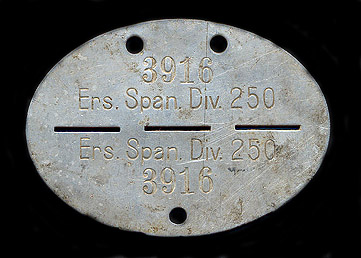
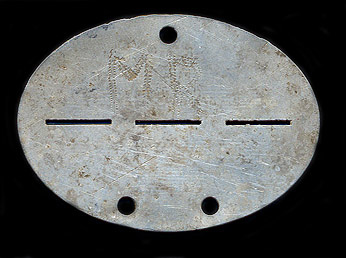
Rare Spanish Blue Division "Erkennungsmarken" (Dog-Tag) from the collection of Mario de Cocq.
| Spanish Eastern Front Award The Spanish Government under Francisco Franco produced and issued many awards to volunteers and "Falange" party members. One of the most recognizable and prestigious awards is the Commemorative Medal for Spanish Volunteers in the Struggle against Bolshevism. However, this award was issued by the German Government and later reproduced by the Spanish Goverment as replacement piece for veterans.
| The Spanish Eastern Front Medal 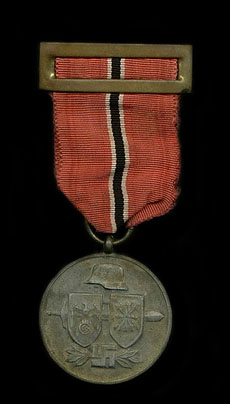
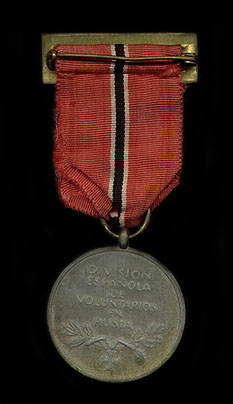
The "Erinnerungsmedaille fur die Spanischen Freiwilligen
im Kampf gegen den Bolschewismus" (Commemorative Medal for Spanish Volunteers
in the Struggle against Bolshevism) is also referred as the Spanish Blue Division
Eastern Front medal. 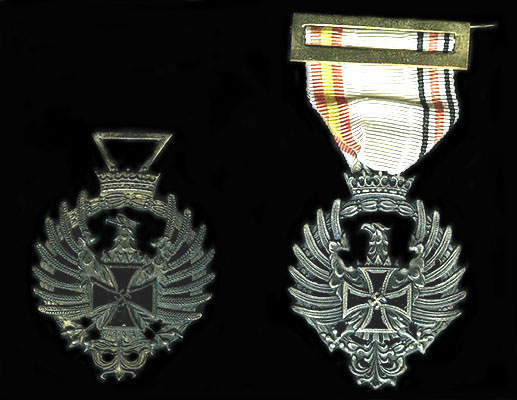
The Spanish Government presented the Division with a commemorative medal of its own.
This award was surmounted by a Spanish Crown, with its main feature the eagle of Saint Andrew and enamel Iron Cross in the center, representative of the collaboration between the nations. The reverse shows the cathedral of Saint Sophia, behind the wall of the Kremlin and below is the inscription "Rusia 1941," surrounded by a broken chain, denoting that the struggle was in the East. It was held by a white ribbon that had on either side with the national colors of Spain and the Third Reich. 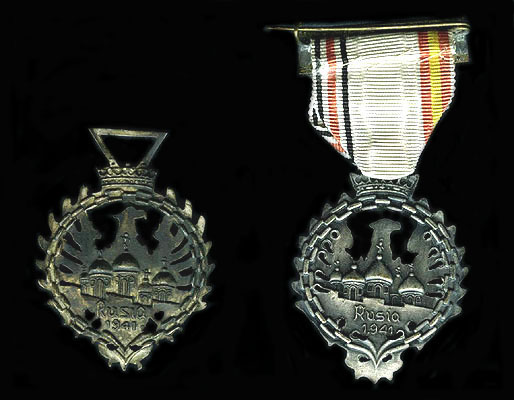
However, these post-war medals are not considered reproductions as the Spanish Government officially sanctioned them. The pre-war award was presented in a cardboard box measuring 92 mm x 47 mm x 16 mm and has the inscription "MEDALLA DE TROPA-DONATIVO DEL MINISTERIO DEL EJERCITO" (Troop Medal-Donated by the Army Ministry).
| Spanish War Cross for Officer and Enlisted 
The Spanish War Cross was instituted on 14 March 1942 and awarded for distinguished acts or
services that proved especially effective in the outcome of a battle or combat. On the left side
is the cross with swords and palms. In the center of the cross is the royal crown, which is attached separately.
| Spanish War Cross Award Document 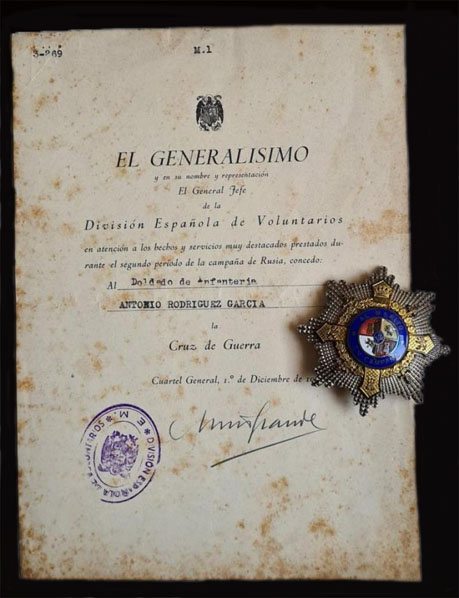
Above is a rare Spanish Blue Division War Cross award document with War Cross given to an infantry soldier. The document has a nice purple Spanish Blue Division seal and has been hand signed by General Muñoz Grandes.
| Spanish War Cross for Enlisted 
Above is the Spanish war cross with swords for enlisted and small blue carton box made by the firm Egaña.
| Spanish Blue 3rd squadron badge 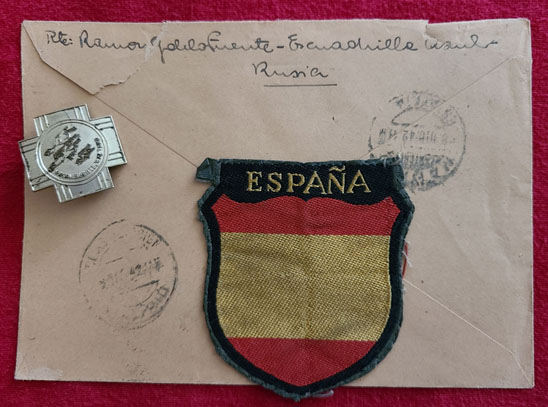
The Spanish Blue Squadrons (Escuadrilla Azul) served in the German Luftwaffe successively from the autumn of 1941 to the spring of 1944 it was attached to Staffel in Jagdgeschwader 27 comprising of the 1st squadron and Jagdgeschwader 51 comprising of 2nd, 3rd, 4th and 5th squadrons. These Spanish squadrons rotated through the Eastern Front. No more than 120 men were the strength of each squadron, including ground support forces.
| Spanish Blue Division Medal Bar 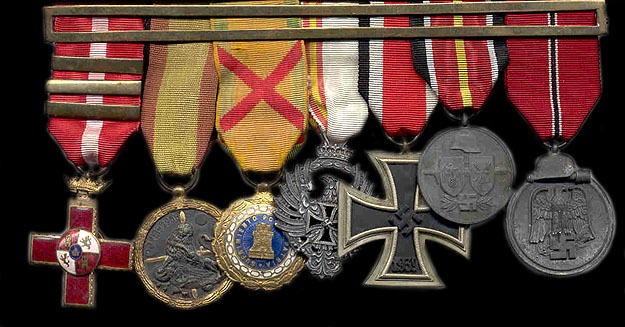
Seven piece medal display bar worn by a highly decorated Blue Division veteran. 
Spanish veteran service bar from left to right:
| Spanish Eastern Front Award Documents Rare Spanish Eastern Front award document dated in November 1943. During this period the Blue Division was being withdrawn to Spain. The document is hand written and has been signed by the German Commander of the 18th Army, Generaloberst Lindemann. This document is part of the collection of Mr. Luis Navarro. 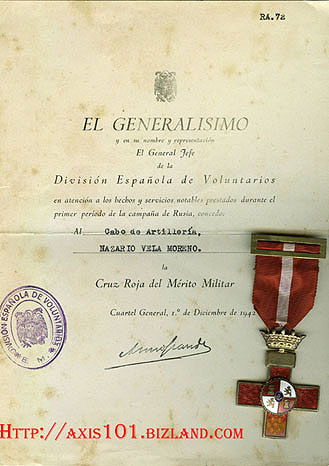
The red Cross Merit medal document dated December 1st 1942. This Spanish
document was awarded to a Spaniard in the Blue Division. The document has a
facsimile signature of General Muñoz Grandes.
| Spanish Falange Badge 
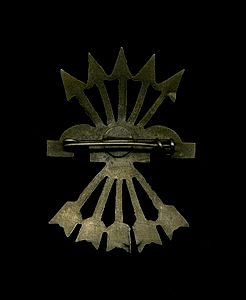
A large percentage of Spaniards that volunteered to fight in the Eastern Front were members of Falangist movement (Franco's fascist party), which was the only legal party allowed in Spain. These volunteers were allowed to wear on their German uniforms a blue shirt hence the reference of the Spanish Blue Division. The blue shirt was a symbolic representation of the Falalgist party. Another popular party emblem was the Falange "Yoke-and-Arrows." The emblem comes from the period of the Catholic Kings of Spain (Fernando and Ysabel). The yoke is an ancient symbol for Queen Ysabel, and the arrows the symbol for King Fernando. The badge shown above was worn on German uniform, on the side of the cap and attached in the center of the national shield. The reverse shows a security pin attached by means of a small circular plate. The badge is made of zinc and was manufactured in Mallorca, Spain.
|
Blue Division Collection 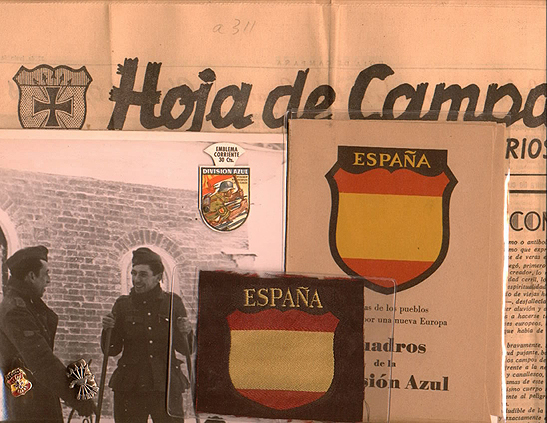
In the background is a very rare Spanish Blue Division campaign newspaper printed in Riga, Latvia in June 1943. In front shows an official war press picture showing Spaniards in the Eastern Front, dated January 8, 1942. On top of the picture is a charity label. Next to it is a rare postcard sleeve pocket showing the divisions national shield. Below on the corner are membership pins for the Falangist and Spanish Blue Division veterans. The shield shown is Spanish made and issued to Blue Divison veterans. |